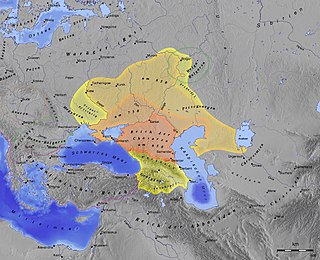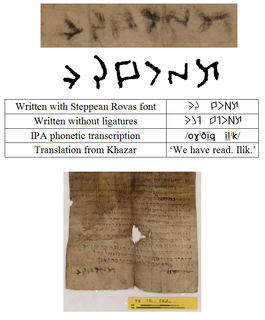Khazar myth may refer to
- Khazar hypothesis of Ashkenazi ancestry
- Khazar hypothesis of Cossack ancestry
- An element of Khazar mythology
Khazar myth may refer to

The Khazars were a semi-nomadic Turkic people with a confederation of Turkic tribes that in the late 6th century CE established a major commercial empire covering the southeastern section of modern European Russia, southern Ukraine, Crimea and Kazakhstan. The Khazars created what for its duration was the most powerful polity to emerge from the break-up of the Western Turkic Khaganate. Astride a major artery of commerce between Eastern Europe and Southwestern Asia, Khazaria became one of the foremost trading empires of the medieval world, commanding the western marches of the Silk Road and playing a key commercial role as a crossroad between China, the Middle East and Kievan Rus'. For some three centuries the Khazars dominated the vast area extending from the Volga-Don steppes to the eastern Crimea and the northern Caucasus.

Sviatoslav I Igorevich, also spelled Svyatoslav, was a Grand Prince of Kiev famous for his persistent campaigns in the east and south, which precipitated the collapse of two great powers of Eastern Europe, Khazaria and the First Bulgarian Empire. He also conquered numerous East Slavic tribes, defeated the Alans and attacked the Volga Bulgars, and at times was allied with the Pechenegs and Magyars.

"Ancient astronauts" refers to the idea, often presented in a pseudoscientific way, that intelligent extraterrestrial beings visited Earth and made contact with humans in antiquity and prehistoric times. Proponents suggest that this contact influenced the development of modern cultures, technologies, religions, and human biology. A common position is that deities from most, if not all, religions are extraterrestrial in origin, and that advanced technologies brought to Earth by ancient astronauts were interpreted as evidence of divine status by early humans.
Bulgar is an extinct Oghur Turkic language which was spoken by the Bulgars.
Jewish ethnic divisions refer to many distinctive communities within the world's ethnically Jewish population. Although considered a self-identifying ethnicity, there are distinct ethnic subdivisions among Jews, most of which are primarily the result of geographic branching from an originating Israelite population, mixing with local communities, and subsequent independent evolutions.

The Kievan Letter, or Kyivan letter is an early 10th-century letter thought to be written by representatives of the Jewish community in Kyiv. The letter, a Hebrew-language recommendation written on behalf of one member of their community, was part of an enormous collection brought to Cambridge by Solomon Schechter from the Cairo Geniza. It was discovered in 1962 during a survey of the Geniza documents by Norman Golb of the University of Chicago. The letter is dated by most scholars to around 930 CE. Some think that the letter dates from a time when Khazars were no longer a dominant force in the politics of the city. According to Marcel Erdal, the letter does not come from Kyiv but was sent to Kyiv.
The Khazar Correspondence is a set of documents, which are alleged to date from the 950s or 960s, and to be letters between Hasdai ibn Shaprut, foreign secretary to the Caliph of Cordoba, and Joseph Khagan of the Khazars. The Correspondence is one of only a few documents attributed to a Khazar author, and potentially one of only a small number of primary sources on Khazar history.
Bulan was a Khazar king who led the conversion of the Khazars to Judaism. His name means "elk" or "hart" in Old Turkic. The date of his reign is unknown, as the date of the conversion is hotly disputed, though it is certain that Bulan reigned some time between the mid-8th and the mid-9th centuries. Nor is it settled whether Bulan was the Bek or the Khagan of the Khazars.

The Thirteenth Tribe is a 1976 book by Arthur Koestler, in which the author advances the thesis that Ashkenazi Jews are not descended from the historical Israelites of antiquity, but from Khazars, a Turkic people. Koestler hypothesized that the Khazars migrated westwards into Eastern Europe in the 12th and 13th centuries when the Khazar Empire was collapsing.
Deyvid Franck Silva Sacconi or simply Deyvid Sacconi, is a Brazilian attacking midfielder. Due to his Italian ancestry he holds an Italian passport.

The Proto-Indo-European homeland was the prehistoric Urheimat of the Indo-European languages – the region where the proposed common ancestor of those languages, the Proto-Indo-European language (PIE), was originally spoken. From this region, its speakers migrated east and west, and went on to form the proto-communities of the different branches of the language family.

Shlomo Sand is an Israeli Emeritus Professor of History at Tel Aviv University.
Genetic studies on Jews are part of the population genetics discipline and are used to better understand the chronology of migration provided by research in other fields, such as history, archaeology, linguistics, and paleontology. These studies investigate the origins of various Jewish populations today. In particular, they investigate whether there is a common genetic heritage among various Jewish populations.
The Japanese-Jewish common ancestry theory is a fringe theory that appeared in the 17th century as a hypothesis which claimed the Japanese people were the main part of the Ten Lost Tribes of Israel. A later version portrayed them as descendants of a tribe of Central Asian Jewish converts to Nestorian Christianity. Some versions of the theory applied to the whole population, but others only claimed that a specific group within the Japanese people had descended from Jews.

The Invention of the Jewish People is a study of the historiography of the Jewish people by Shlomo Sand, Professor of History at Tel Aviv University. It has generated a heated controversy. The book was in the best-seller list in Israel for nineteen weeks.
Did Jesus Exist? may refer to:
The Khazar hypothesis of Ashkenazi ancestry, often called the Khazar myth, is a largely abandoned historical hypothesis that has sometimes been abused to further antisemitic or anti-Zionist agendas. The hypothesis postulated that Ashkenazi Jews were primarily, or to a large extent, descended from Khazars, a multi-ethnic conglomerate of mostly Turkic peoples who formed a semi-nomadic Khanate in and around the northern and central Caucasus and the Pontic-Caspian steppe. The hypothesis draws on some medieval sources such as the Khazar Correspondence, according to which at some point in the 8th–9th centuries, a small number of Khazars were said by Judah Halevi and Abraham ibn Daud to have converted to Rabbinic Judaism. The scope of the conversion within the Khazar Khanate remains uncertain, but the evidence used to tie the Ashkenazi communities to the Khazars is meager and subject to conflicting interpretations.
Paul Wexler is an American-born Israeli linguist, and Professor Emeritus of linguistics at Tel Aviv University. His research fields include historical linguistics, bilingualism, Slavic linguistics, creole linguistics, Romani (Gypsy) and Jewish languages.
Eran Elhaik is an Israeli-American geneticist and bioinformatician, and an associate professor of bioinformatics at Lund University in Sweden. His research uses computational, statistical, epidemiological and mathematical approaches to fields such as complex disorders, population genetics, personalised medicine, molecular evolution, genomics, paleogenomics and epigenetics.
The Khazar hypothesis of Cossack ancestry, also known as the Khazarism, Khazar Cossack myth or Khazar myth, is a claim that the Ukrainian Cossacks descended from Khazars. With traces in the 17th century, it was propagated in the 18th century as an element of the legilimization of the Ukrainian Cossack autonomy. In particular, it was put forth in the Constitution of Pylyp Orlyk. Its origin may be traced to the contemporary Polish historiography.